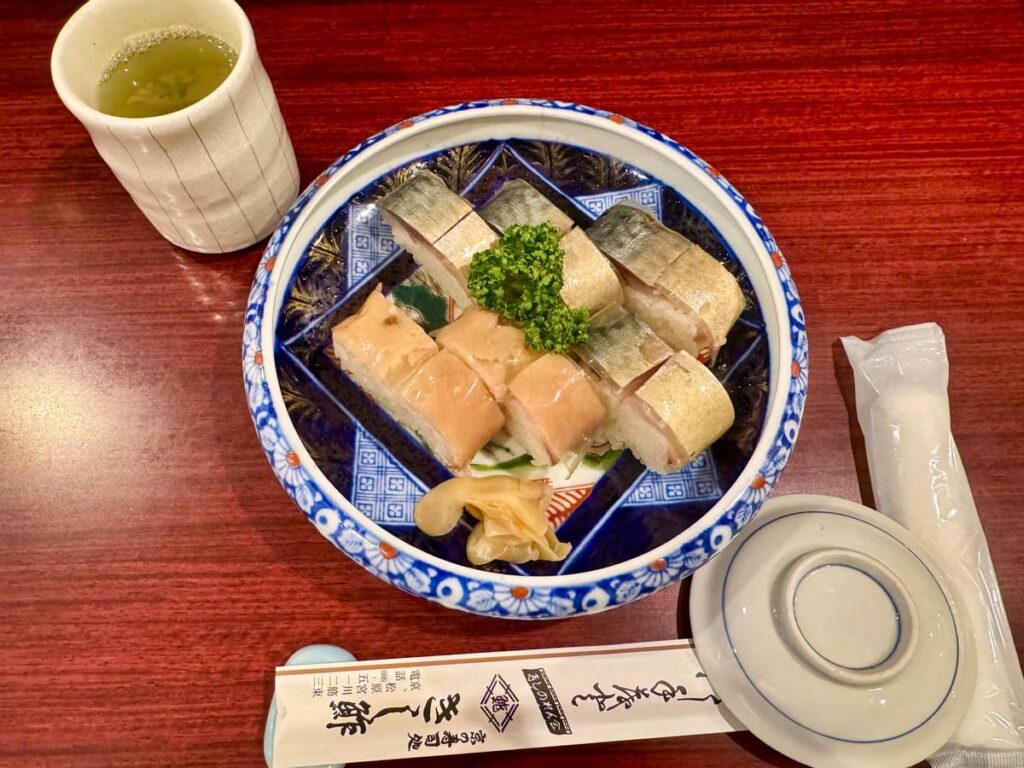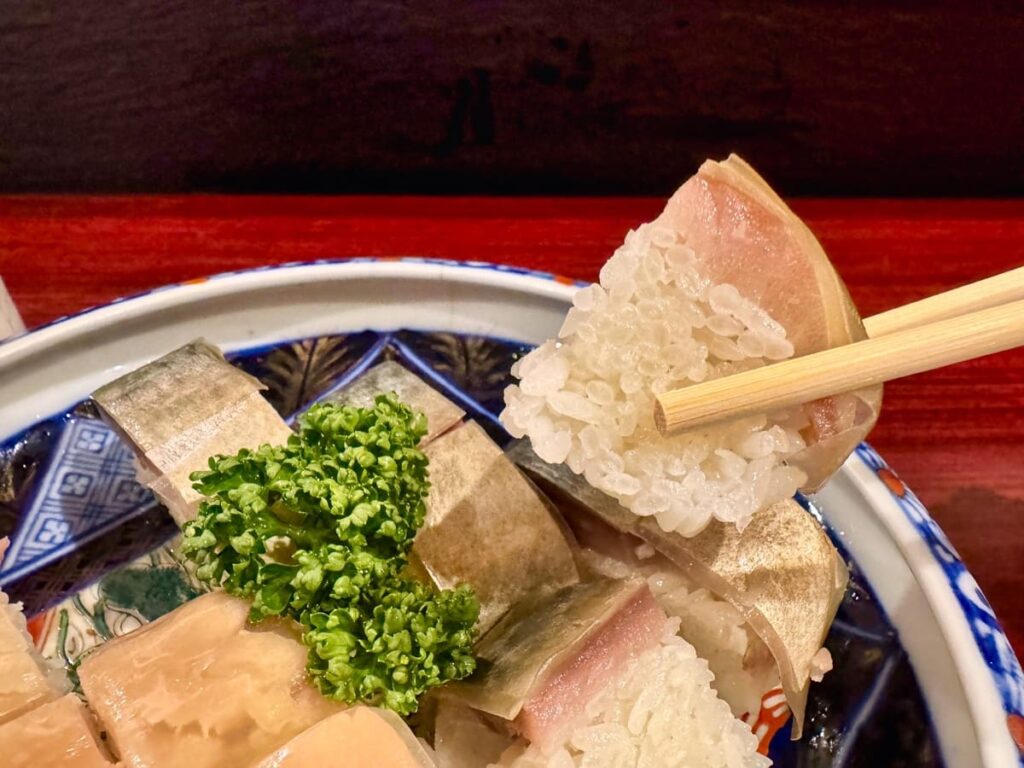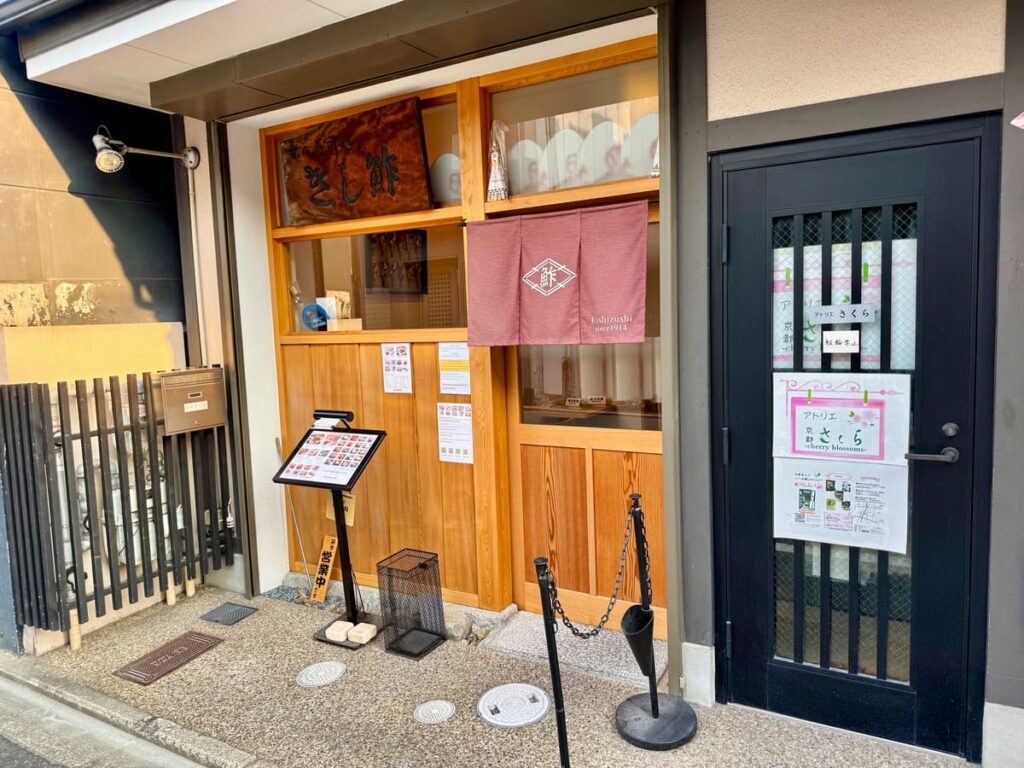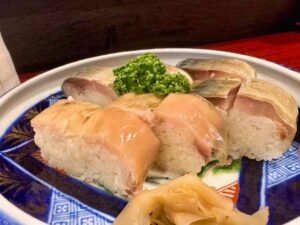Recently, for some reason, I started thinking, “I want to eat sushi that can only be eaten in Kyoto.” There are several high-end Edo-style sushi restaurants in Kyoto where a single meal can cost tens of thousands of yen, but you can eat that kind of sushi in Tokyo or Osaka too (setting aside the real reason that “I can’t afford it” for now…). What I really wanted was sushi that was truly unique to Kyoto.
Since then, I’ve been surfing the internet and flipping through gourmet books at large bookstores, and I’ve found a few places that piqued my interest. The first one I’d like to introduce is Kishizushi, located in Miyagawa-cho. What makes this sushi “Kyoto-unique”? I’ll explain that in the following sections, so please keep reading until the end…
At first glance, it looks like a typical neighborhood sushi restaurant, but it is actually a long-established restaurant that has been in business for over 100 years… Kishizushi is a restaurant like this…
I visited Kishizushi at around 6:00 p.m. on a Sunday evening. The restaurant is located in a quiet area a short distance south of Gion, and there were few people on the street in front of the restaurant. The exterior of the restaurant also looked like a typical neighborhood sushi restaurant, blending in completely with the surrounding atmosphere. When I opened the door and peeked inside, there was an empty seat at the counter, so I sat down as the owner gestured for me to do so.
The size of the interior is a bit hard to compare, but it’s about the same as a typical ramen shop… In that compact space, there were six counter seats along the kitchen and six table seats, totaling 12 seats for customers. It was simple yet spotlessly clean, with none of the oppressive atmosphere of a high-end restaurant. The owner, who runs the shop from the kitchen, is quiet but exudes a warm, friendly aura. Apparently, he is the fourth-generation owner. In fact, Kishizushi was founded in 1914, making it a century-old establishment. Hearing that a sushi restaurant has been in business for over 100 years in Kyoto, which is far from the sea, makes me look at it with great respect… But this restaurant doesn’t have that kind of pretentiousness, and I think it’s a place where even a lone customer like me can feel comfortable.
This is definitely “sushi that can only be eaten in Kyoto.” How was the 6-piece mackerel sushi at Kishizushi?
Now, let me introduce the Kyoto specialty mackerel sushi that I ordered at Kishizushi on that day. There are two options for mackerel sushi: 3 pieces and 6 pieces. The price for the 6 pieces I ordered was 2,500 yen including tax (the 3 pieces are 1,300 yen including tax)…

After waiting about 10 minutes after placing my order, the 6 pieces of mackerel sushi were brought to my table. This mackerel sushi isn’t pre-made; it’s made fresh after the order is placed. I actually saw the owner removing the small bones from the mackerel over the counter, and being able to watch the preparation process right in front of me really increased my sense of reassurance about what I was about to eat. And, as you can see in the image above… the mackerel sushi is shining brightly. This is due to the white nori seaweed covering the surface, and honestly, seeing it in front of me, I thought, “It’s a shame to eat it…”

But it would be a shame not to eat it while it’s fresh, so I picked up a piece with my chopsticks and took a bite… and was surprised when I put it in my mouth. Mackerel sushi is typically made with vinegar, so it has a sour taste, but this mackerel sushi is mildly sour and even a bit sweet. This is because the vinegar used in this mackerel sushi is not ordinary vinegar, but a special Kyoto-style vinegar called Chidori vinegar. I think the white nori was probably soaked in Chidori vinegar, which is why the surface is so shiny.
On the other hand, the mackerel and rice don’t have much acidity. In fact, this is another unique feature of Kyoto sushi: the rice is cooked with bonito broth. When I took the mackerel out and tasted the rice alone, I could feel the light acidity and sweetness, as well as the strong flavor of the broth. Apparently, cooking rice with bonito broth to make sushi rice is a traditional Kyoto sushi practice. So, with Kishizushi’s mackerel sushi, with each bite, the broth flavor slowly emerges from both the mackerel and the rice… It’s mackerel sushi that’s enjoyed not for its acidity but for its broth flavor. This is truly “Kyoto-style.”
Additionally, the owner’s thoughtfulness in cutting each piece of mackerel sushi in half to make it easier to eat is also commendable. I wondered if this might be a geisha-style serving, but at this size, even women and small children can enjoy it in one bite. The rice has just the right firmness—it doesn’t crumble when picked up with chopsticks—making it easier to eat than the hard rice found in takeout versions sold at souvenir shops. While this mackerel sushi is available for takeout, I would recommend enjoying it fresh at the restaurant if possible.
If possible, it is recommended to make a reservation in advance… Kishizushi is located a 7-minute walk from the nearest station, Keihan Railway Shimizu Gojo Station.
If possible, it is recommended to make a reservation in advance for Kishizushi, as the restaurant’s capacity seems to be quite limited. In fact, during the time I was at the store, even though there were empty table seats, they were posting an entry restriction notice outside the store when the counter seats were full. I suppose the owner is running the store at their own pace. In a different sense from a popular restaurant with long lines, dining here might be surprisingly challenging.
Here are the details of the store…

Kishizushi Out of 5
Address: 615-0801 Kyoto Prefecture, Kyoto City, Higashiyama Ward, Miyagawa-suji 5-chome 333-1
Phone number: 075-606-5123 (phone reservations accepted during opening hours only)
Business hours: 5:00 PM to 8:30 PM
Closed: Wednesdays (other irregular holidays may apply. Please check the store’s Instagram)
Parking: None
Credit card payments: Accepted (PayPay, electronic money, and transportation IC cards also accepted)
It’s a 9-minute walk from the neighboring Keihan Railway Gion-Shijo Station.


Leave a Reply